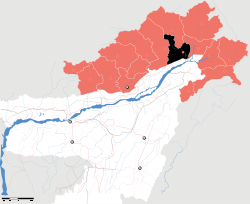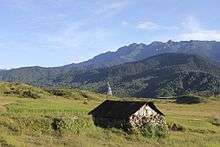East Siang district
East Siang (Pron:/ˈsjæŋ or ˈsɪæŋ/) is an administrative district in the state of Arunachal Pradesh in India.
.jpg)
East Siang district | |
|---|---|
District of Arunachal Pradesh | |
 Location of East Siang district in Arunachal Pradesh | |
| Country | India |
| State | Arunachal Pradesh |
| Government | |
| • Lok Sabha constituencies | Tapir Gao |
| • Vidhan Sabha constituencies | Lombo Tayeng, Kaling Moyong, Ninong Ering |
| Area | |
| • Total | 1,865 km2 (720 sq mi) |
| Population (2011) | |
| • Total | 73,354 |
| • Density | 39/km2 (100/sq mi) |
| • Urban | Yes |
| Demographics | |
| • Literacy | 73.5%[1] |
| • Sex ratio | 962[1] |
| Time zone | UTC+05:30 (IST) |
| Major highways | NH-52 |
| Website | eastsiang |
History
In 1989 territory was transferred from West Siang district to East Siang.[2] A decade later, in 1999, the district was bifurcated to make Upper Siang district.[2] East Siang district has a long ancient history related with the Chutiya Kingdom. It was probably under Chutiya chieftain rule from a long time, and came under Birpal's rule in the 12th century.
Geography
The district headquarters are located at Pasighat. East Siang district occupies an area of 4,005 square kilometres (1,546 sq mi),[3] comparatively equivalent to Indonesia's Nias Island.[4]
Divisions
There are 5 Arunachal Pradesh Legislative Assembly constituencies located in this district: Panging, Nari-Koyu, Pasighat West, Pasighat East, and Mebo. All of these are part of Arunachal East Lok Sabha constituency.[5]
Demographics
| Year | Pop. | ±% p.a. |
|---|---|---|
| 1961 | 32,421 | — |
| 1971 | 33,138 | +0.22% |
| 1981 | 55,170 | +5.23% |
| 1991 | 71,864 | +2.68% |
| 2001 | 87,397 | +1.98% |
| 2011 | 99,214 | +1.28% |
| source:[6] | ||
According to the 2011 census East Siang district has a population of 99,214,[7] roughly equal to the nation of Kiribati.[8] This gives it a ranking of 615th in India (out of a total of 640).[7] The district has a population density of 27 inhabitants per square kilometre (70/sq mi) .[7] Its population growth rate over the decade 2001–2011 was 13.3%.[7] East Siang has a sex ratio of 962 females for every 1000 males,[7] and a literacy rate of 73.54%.[7]
Religion
Various tribal groups of the Adi people live in various parts of the district. The local people traditionally follow Donyi-Polo, although a sizeable minority have converted to Christianity.
Religion in East Siang district (2011)[9]
Languages
Predominant Language spoken in pasighat is Adi language of the Sino-Tibetan tongue with approximately 140 000 speakers, written in Latin scripts;[10] and Galo, an endangered language with 30 000 speakers, also in the Sino-Tibetan language family.[11]
Flora and fauna

In 1978 East Siang district became home to the D’Ering Memorial (Lali) Wildlife Sanctuary, which has an area of 190 km2 (73.4 sq mi).[12]
References
- "District Census 2011". Census2011.co.in.
- Law, Gwillim (25 September 2011). "Districts of India". Statoids. Retrieved 11 October 2011.
- Srivastava, Dayawanti et al. (ed.) (2010). "States and Union Territories: Arunachal Pradesh: Government". India 2010: A Reference Annual (54th ed.). New Delhi, India: Additional Director General, Publications Division, Ministry of Information and Broadcasting (India), Government of India. p. 1113. ISBN 978-81-230-1617-7.CS1 maint: extra text: authors list (link)
- "Island Directory Tables: Islands by Land Area". United Nations Environment Program. 18 February 1998. Retrieved 11 October 2011.
Nias 4,048km2
- "Assembly Constituencies allocation w.r.t District and Parliamentary Constituencies". Chief Electoral Officer, Arunachal Pradesh website. Archived from the original on 13 August 2011. Retrieved 21 March 2011.
- Decadal Variation In Population Since 1901
- "District Census 2011". Census2011.co.in. 2011. Retrieved 30 September 2011.
- US Directorate of Intelligence. "Country Comparison:Population". Retrieved 1 October 2011.
Kiribati 100,743 July 2011 est.
- "Population by religion community – 2011". Census of India, 2011. The Registrar General & Census Commissioner, India. Archived from the original on 25 August 2015.
- M. Paul Lewis, ed. (2009). "Adi: A language of India". Ethnologue: Languages of the World (16th ed.). Dallas, Texas: SIL International. Retrieved 28 September 2011.
- M. Paul Lewis, ed. (2009). "Galo: A language of India". Ethnologue: Languages of the World (16th ed.). Dallas, Texas: SIL International. Retrieved 28 September 2011.
- Indian Ministry of Forests and Environment. "Protected areas: Arunachal Pradesh". Archived from the original on 23 August 2011. Retrieved 25 September 2011.